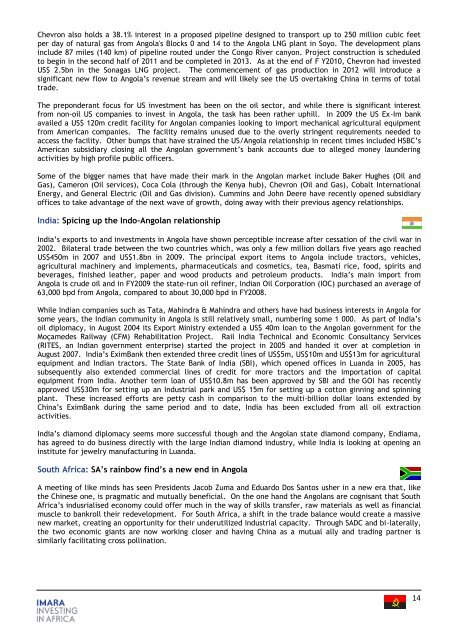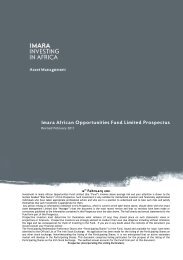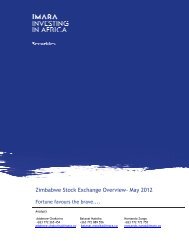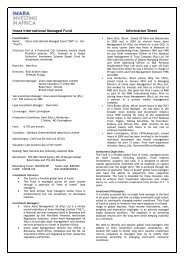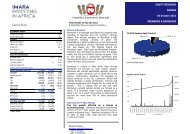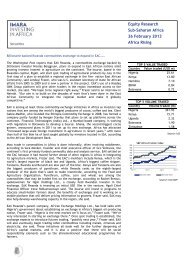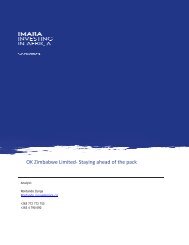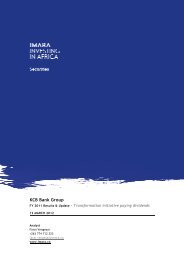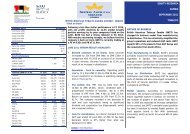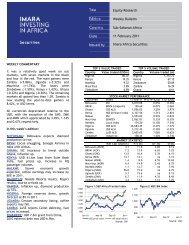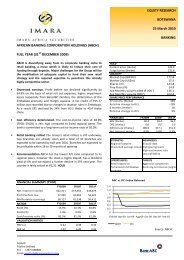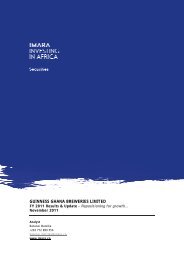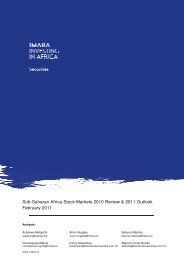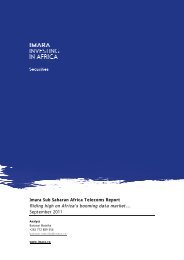Imara African Cement Report Africa, the last cement frontier Angola ...
Imara African Cement Report Africa, the last cement frontier Angola ...
Imara African Cement Report Africa, the last cement frontier Angola ...
You also want an ePaper? Increase the reach of your titles
YUMPU automatically turns print PDFs into web optimized ePapers that Google loves.
Chevron also holds a 38.1% interest in a proposed pipeline designed to transport up to 250 million cubic feet<br />
per day of natural gas from <strong>Angola</strong>'s Blocks 0 and 14 to <strong>the</strong> <strong>Angola</strong> LNG plant in Soyo. The development plans<br />
include 87 miles (140 km) of pipeline routed under <strong>the</strong> Congo River canyon. Project construction is scheduled<br />
to begin in <strong>the</strong> second half of 2011 and be completed in 2013. As at <strong>the</strong> end of F Y2010, Chevron had invested<br />
US$ 2.5bn in <strong>the</strong> Sonagas LNG project. The commen<strong>cement</strong> of gas production in 2012 will introduce a<br />
significant new flow to <strong>Angola</strong>‟s revenue stream and will likely see <strong>the</strong> US overtaking China in terms of total<br />
trade.<br />
The preponderant focus for US investment has been on <strong>the</strong> oil sector, and while <strong>the</strong>re is significant interest<br />
from non-oil US companies to invest in <strong>Angola</strong>, <strong>the</strong> task has been ra<strong>the</strong>r uphill. In 2009 <strong>the</strong> US Ex-Im bank<br />
availed a US$ 120m credit facility for <strong>Angola</strong>n companies looking to import mechanical agricultural equipment<br />
from American companies. The facility remains unused due to <strong>the</strong> overly stringent requirements needed to<br />
access <strong>the</strong> facility. O<strong>the</strong>r bumps that have strained <strong>the</strong> US/<strong>Angola</strong> relationship in recent times included HSBC‟s<br />
American subsidiary closing all <strong>the</strong> <strong>Angola</strong>n government‟s bank accounts due to alleged money laundering<br />
activities by high profile public officers.<br />
Some of <strong>the</strong> bigger names that have made <strong>the</strong>ir mark in <strong>the</strong> <strong>Angola</strong>n market include Baker Hughes (Oil and<br />
Gas), Cameron (Oil services), Coca Cola (through <strong>the</strong> Kenya hub), Chevron (Oil and Gas), Cobalt International<br />
Energy, and General Electric (Oil and Gas division). Cummins and John Deere have recently opened subsidiary<br />
offices to take advantage of <strong>the</strong> next wave of growth, doing away with <strong>the</strong>ir previous agency relationships.<br />
India: Spicing up <strong>the</strong> Indo-<strong>Angola</strong>n relationship<br />
India‟s exports to and investments in <strong>Angola</strong> have shown perceptible increase after cessation of <strong>the</strong> civil war in<br />
2002. Bilateral trade between <strong>the</strong> two countries which, was only a few million dollars five years ago reached<br />
US$450m in 2007 and US$1.8bn in 2009. The principal export items to <strong>Angola</strong> include tractors, vehicles,<br />
agricultural machinery and implements, pharmaceuticals and cosmetics, tea, Basmati rice, food, spirits and<br />
beverages, finished lea<strong>the</strong>r, paper and wood products and petroleum products. India‟s main import from<br />
<strong>Angola</strong> is crude oil and in FY2009 <strong>the</strong> state-run oil refiner, Indian Oil Corporation (IOC) purchased an average of<br />
63,000 bpd from <strong>Angola</strong>, compared to about 30,000 bpd in FY2008.<br />
While Indian companies such as Tata, Mahindra & Mahindra and o<strong>the</strong>rs have had business interests in <strong>Angola</strong> for<br />
some years, <strong>the</strong> Indian community in <strong>Angola</strong> is still relatively small, numbering some 1 000. As part of India‟s<br />
oil diplomacy, in August 2004 its Export Ministry extended a US$ 40m loan to <strong>the</strong> <strong>Angola</strong>n government for <strong>the</strong><br />
Moçamedes Railway (CFM) Rehabilitation Project. Rail India Technical and Economic Consultancy Services<br />
(RITES, an Indian government enterprise) started <strong>the</strong> project in 2005 and handed it over at completion in<br />
August 2007. India‟s EximBank <strong>the</strong>n extended three credit lines of US$5m, US$10m and US$13m for agricultural<br />
equipment and Indian tractors. The State Bank of India (SBI), which opened offices in Luanda in 2005, has<br />
subsequently also extended commercial lines of credit for more tractors and <strong>the</strong> importation of capital<br />
equipment from India. Ano<strong>the</strong>r term loan of US$10.8m has been approved by SBI and <strong>the</strong> GOI has recently<br />
approved US$30m for setting up an Industrial park and US$ 15m for setting up a cotton ginning and spinning<br />
plant. These increased efforts are petty cash in comparison to <strong>the</strong> multi-billion dollar loans extended by<br />
China‟s EximBank during <strong>the</strong> same period and to date, India has been excluded from all oil extraction<br />
activities.<br />
India‟s diamond diplomacy seems more successful though and <strong>the</strong> <strong>Angola</strong>n state diamond company, Endiama,<br />
has agreed to do business directly with <strong>the</strong> large Indian diamond industry, while India is looking at opening an<br />
institute for jewelry manufacturing in Luanda.<br />
South <strong>Africa</strong>: SA’s rainbow find’s a new end in <strong>Angola</strong><br />
A meeting of like minds has seen Presidents Jacob Zuma and Eduardo Dos Santos usher in a new era that, like<br />
<strong>the</strong> Chinese one, is pragmatic and mutually beneficial. On <strong>the</strong> one hand <strong>the</strong> <strong>Angola</strong>ns are cognisant that South<br />
<strong>Africa</strong>‟s indusrialised economy could offer much in <strong>the</strong> way of skills transfer, raw materials as well as financial<br />
muscle to bankroll <strong>the</strong>ir redevelopment. For South <strong>Africa</strong>, a shift in <strong>the</strong> trade balance would create a massive<br />
new market, creating an opportunity for <strong>the</strong>ir underutilized industrial capacity. Through SADC and bi-laterally,<br />
<strong>the</strong> two economic giants are now working closer and having China as a mutual ally and trading partner is<br />
similarly facilitating cross pollination.<br />
14


